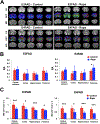APOE genotype-dependent pharmacogenetic responses to rapamycin for preventing Alzheimer's disease
- PMID: 32173556
- PMCID: PMC7486698
- DOI: 10.1016/j.nbd.2020.104834
APOE genotype-dependent pharmacogenetic responses to rapamycin for preventing Alzheimer's disease
Abstract
The ε4 allele of Apolipoprotein (APOE4) is the strongest genetic risk factor for Alzheimer's disease (AD), the most common form of dementia. Cognitively normal APOE4 carriers have developed amyloid beta (Aβ) plaques and cerebrovascular, metabolic and structural deficits decades before showing the cognitive impairment. Interventions that can inhibit Aβ retention and restore the brain functions to normal would be critical to prevent AD for the asymptomatic APOE4 carriers. A major goal of the study was to identify the potential usefulness of rapamycin (Rapa), a pharmacological intervention for extending longevity, for preventing AD in the mice that express human APOE4 gene and overexpress Aβ (the E4FAD mice). Another goal of the study was to identify the potential pharmacogenetic differences in response to rapamycin between the E4FAD and E3FAD mice, the mice with human APOE ε3 allele. We used multi-modal MRI to measure in vivo cerebral blood flow (CBF), neurotransmitter levels, white matter integrity, water content, cerebrovascular reactivity (CVR) and somatosensory response; used behavioral assessments to determine cognitive function; used biochemistry assays to determine Aβ retention and blood-brain barrier (BBB) functions; and used metabolomics to identify brain metabolic changes. We found that in the E4FAD mice, rapamycin normalized bodyweight, restored CBF (especially in female), BBB activity for Aβ transport, neurotransmitter levels, neuronal integrity and free fatty acid level, and reduced Aβ retention, which were not observe in the E3FAD-Rapa mice. In contrast, E3FAD-Rapa mice had lower CVR responses, lower anxiety and reduced glycolysis in the brain, which were not seen in the E4FAD-Rapa mice. Further, rapamycin appeared to normalize lipid-associated metabolism in the E4FAD mice, while slowed overall glucose-associated metabolism in the E3FAD mice. Finally, rapamycin enhanced overall water content, water diffusion in white matter, and spatial memory in both E3FAD and E4FAD mice, but did not impact the somatosensory responses under hindpaw stimulation. Our findings indicated that rapamycin was able to restore brain functions and reduce AD risk for young, asymptomatic E4FAD mice, and there were pharmacogenetic differences between the E3FAD and E4FAD mice. As the multi-modal MRI methods used in the study are readily to be used in humans and rapamycin is FDA-approved, our results may pave a way for future clinical testing of the pharmacogenetic responses in humans with different APOE alleles, and potentially using rapamycin to prevent AD for asymptomatic APOE4 carriers.
Keywords: APOE3; APOE4; Alzheimer's disease prevention; Amyloid-beta plaques; Blood brain barrier; Cerebral blood flow; Cerebrometabolic function; Cerebrovascular reactivity; Cognition; MRI; Neuroinflammation; Pharmacogentics; Rapamycin; Water content; White matter integrity; mTOR.
Copyright © 2020. Published by Elsevier Inc.
Figures








References
-
- Janocko NJ, Brodersen KA, Soto-Ortolaza AI, Ross OA, Liesinger AM, Duara R, et al. Neuropathologically defined subtypes of Alzheimer’s disease differ significantly from neurofibrillary tangle-predominant dementia. Acta Neuropathologica. 2012;124(5):681–92. doi: 10.1007/s00401-012-1044-y. - DOI - PMC - PubMed
-
- Fleisher AS, Chen K, Liu X, Ayutyanont N, Roontiva A, Thiyyagura P, et al. Apolipoprotein E epsilon4 and age effects on florbetapir positron emission tomography in healthy aging and Alzheimer disease. Neurobiol Aging. 2013;34(1):1–12. Epub 2012/05/29. doi: 10.1016/j.neurobiolaging.2012.04.017. - DOI - PubMed
-
- Farrer LA, Cupples LA, Haines JL, Hyman B, Kukull WA, Mayeux R, et al. Effects of age, sex, and ethnicity on the association between apolipoprotein E genotype and Alzheimer disease. A meta-analysis. APOE and Alzheimer Disease Meta Analysis Consortium. Jama. 1997;278(16):1349–56. Epub 1997/10/29. - PubMed
Publication types
MeSH terms
Substances
Grants and funding
LinkOut - more resources
Full Text Sources
Medical
Research Materials
Miscellaneous

